Unlike traditional erotic literature, these narratives regularly combine factors of delusion, anime, and manga-stimulated storytelling. The appeal of hentai stories lies no longer simply in their explicit content but also in their capability to create imaginative worlds that permit readers to discover scenarios beyond reality. This style has grown notably with the upward thrust of virtual structures, giving creators the freedom to test with topics and storytelling patterns that conventional media may restrict.
Origins and Evolution
The roots of hentai stories testimonies may be traced back to early Japanese erotic artwork and literature, where illustrated works referred to as ‘shunga’ depicted intimate scenes. With the improvement of manga and anime in the 20th century, these erotic elements regularly transformed into contemporary hentai narratives.
Initially, these tales had been confined to print and areas of interest, but the net has played a major role in popularizing them internationally. Digital accessibility has enabled a variety of creators to post content, introducing new issues, styles, and story systems that appeal to a worldwide audience.
Narrative Styles and Themes
Hentai stories and tales are not limited to a single narrative fashion; they encompass many storytelling processes. Some focus on romantic or emotional connections among characters, whilst others explore fantastical or exceedingly creative scenarios. Themes can also encompass supernatural elements, science fiction, or historical settings.
This variety permits readers to interact with content that caters to their precise pastimes, presenting an enormously personalized analysis experience. Despite the person-oriented nature of these stories, sturdy narrative and character development regularly distinguish well-crafted hentai from only visual content.
Character Development and Design
One of the defining functions of hentai stories is the emphasis on character development and improvement. Characters are generally drawn with exaggerated expressions and capabilities, which complements the emotional and visible impact of the tale.
Writers often invest time in creating compelling personalities, motivations, and backgrounds, allowing readers to shape a reference to the characters beyond the erotic elements. The combination of precise visual illustration and rich character depth contributes to the immersive nature of hentai storytelling.
Artistic Expression in Hentai Stories
Art performs a vital function in hentai stories, complementing the narrative with visuals that vary from diffused to explicit. Many creators appoint manga-style illustrations to convey emotion, movement, and intimacy. The artistry often consists of intricate backgrounds, dynamic panel layouts, and thoroughly considered colouration palettes.
In a few instances, the artwork itself will become an imperative issue of the tale, with the visuals using the narrative as a good deal because of the written text. This fusion of art and storytelling has helped hentai testimonies carve out a distinctive region within both erotic literature and the broader global landscape of manga and anime.
Accessibility and Online Communities
The increase of online communities has substantially contributed to the popularity of hentai stories. Websites, forums, and social media platforms permit enthusiasts to share, speak, and propose content material, creating vibrant networks of fanatics.
Digital distribution also provides a degree of anonymity for readers, enabling them to explore the style without judgement. Additionally, fan translations have made hentai stories available to an international audience, bridging cultural and language limitations. These online spaces not only handily foster engagement but also aid rising creators, giving them a platform to show off their work.
Ethical Considerations and Hentai Stories
While hentai stories are a form of creative expression, they also raise ethical concerns due to their explicit nature and, on occasion, controversial themes. Discussions about consent, representation, and the potential effect on visitors are not unusual amongst critics and scholars.
Cultural perceptions of hentai range extensively, with some viewing it as an art form and others as problematic content material. Despite these debates, the style continues to steer broader pop culture, inspiring spin-offs, merchandise, and diversifications in mainstream media. Understanding the cultural context of hentai memories is critical for appreciating their complexity and importance.
Conclusion
Hentai stories constitute a captivating intersection of artwork, narrative, and amusement. Their evolution from conventional erotic art to trendy virtual storytelling highlights the adaptability and creativity of the genre. With diverse topics, attractive characters, and immersive creative expression, those tales offer a unique analysis of revel in that appeals to a global target market. While moral debates persist, the cultural and creative effect of hentai testimonies is simple, showcasing how creativity and storytelling can flourish in even the most obscure area of interest in genres.
